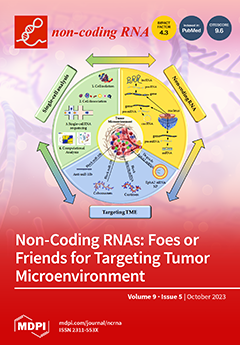Long non-coding RNA (lncRNA) TUG1 acts as a proto-oncogene, allowing the proliferation of tumor cells, and it has been related to inflammation. Therefore, we aimed in this study to investigate for the first time the role of TUG1 gene polymorphism and the TUG1 level as biomarkers in systemic lupus erythematosus (SLE) and their link to lupus nephritis 145 SLE. A total of 145 healthy controls were subjected to clinical and laboratory evaluation. The disease activity was assessed by the SLE disease activity index (SLEDAI) score. SLE patients were divided into two subgroups according to the presence of lupus nephritis. The TUG1 gene polymorphisms rs5749201 and rs886471 were determined by Sanger sequencing, and TUG1 expression was assessed by qRT-PCR. There was a significant increase in the risk of SLE AA, TA, dominant genotypes, and the A allele of rs5749201 (
p < 0.001) by 4.9-, 10.1-, 6.5-, and 2.5-fold in comparison to the relative control. GG and TG, dominant genotypes and the G allele of rs886471 (
p < 0.01) increased the risk by 5.09-, 11.9-, 6.5-, and 2.6-fold. AA, A allele, dominant and recessive rs5749201genotypes increased the risk of lupus nephritis by 16.6-, 7.4-, 7.1-, and 12.2-fold, respectively (
p < 0.05). GG, dominant and recessive genotypes, and the G allele of rs886471 increased the risk of lupus nephritis by 17.04-, 7.8-, 9.4-, and 6.08-fold, respectively (
p < 0.05). Additionally, the AG haplotype increased the risk of SLE and lupus nephritis by 2.7- and 7.8-fold, respectively. The AA rs5749201 and GG rs886471 variants are significantly associated with more severe disease (
p < 0.001). TUG1 expression was significantly higher in SLE than in the control and in the lupus nephritis than in non-lupus nephritis cases (
p < 0.05). Interestingly, AA rs5749201 and GG rs886471 were significantly associated with higher TUG1 levels (
p < 0.001). It was also found that AA rs5749201 and high SLEDAI were predictors of lupus nephritis. Overall, our findings illustrated for the first time that TUG1 gene rs5749201 and rs886471 variants were associated with increased risk of SLE, more severe disease, and lupus nephritis, and the TUG1 level could be used as a diagnostic biomarker of SLE and lupus nephritis.
Full article






